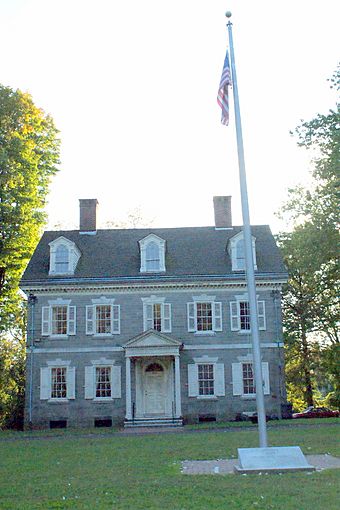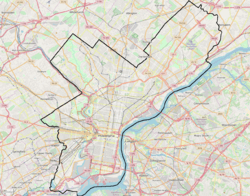Upsala (mansion) facts for kids
Quick facts for kids |
|
|
Upsala
|
|
|
U.S. National Historic Landmark District
Contributing Property |
|

Upsala, October 2009
|
|
| Location | 6430 Germantown Avenue Germantown Philadelphia, Pennsylvania United States |
|---|---|
| Area | < 1-acre (4,000 m2) |
| Built | 1798-1801 |
| Architectural style | Federal |
| NRHP reference No. | 72001174 |
| Added to NRHP | January 13, 1972 |
Upsala is a beautiful old mansion located in Mount Airy, a neighborhood in Philadelphia, Pennsylvania, United States. It's known as a great example of Federal architecture, which was popular in the early days of the United States. This historic house is part of the Colonial Germantown Historic District. It is also listed on the National Register of Historic Places and the Philadelphia Register of Historic Places, meaning it's officially recognized as an important historical site.
During the Battle of Germantown in 1777, American soldiers gathered right where Upsala now stands. They prepared to attack British forces who were across Germantown Avenue at Cliveden, another famous mansion.
Contents
The Story of Upsala Mansion
Early Days and First Buildings
The land where Upsala stands has a long history. In 1698, the first owner, Heivert Papen, built a small house there. It was located near what is now Johnson Street and Germantown Avenue.
Later, the land was owned by Dirck Jansen, one of the first people to settle in Germantown. In 1766, John Johnson, Sr., bought the property. His family was well-known in the area, as his father had built the nearby John Johnson House.
Upsala's Role in the Battle of Germantown
The property played an important part in the Battle of Germantown on October 4, 1777. This was a major battle during the American Revolutionary War. The Continental Army, led by General George Washington, used the land as a gathering spot.
American cannons were set up on the front lawn of the property. From there, they fired at the British soldiers who were defending Cliveden (Benjamin Chew House).
Building the Mansion
John Johnson, III, inherited the property in 1797. He decided to build the grand Upsala Mansion between 1798 and 1801. John Johnson, III, was a Quaker, meaning he was part of a Christian group known for its peaceful beliefs.
In 1801, he married Sally Wheeler. They raised nine children in the new Upsala Mansion. The name "Upsala" might have come from the city of Uppsala in Sweden, but no one is completely sure. Some people also think a family member admired a Swedish writer named Fredrika Bremer and named the house after her hometown.
The small house that Heivert Papen built long ago was taken down in 1883.
Remembering the Battle
Since the 1920s, a special event called the Revolutionary Germantown Festival has taken place every year. It happens on the first Saturday of October. During the festival, people re-enact the Battle of Germantown. This includes showing how the American troops attacked from Upsala Mansion towards Cliveden.
Saving Upsala from Ruin
The Johnson family owned and lived in Upsala Mansion until 1941. At that time, Dr. William Johnson, who was the chief of staff at Germantown Hospital, faced financial difficulties. Because of this, his family lost the property in 1941.
In September 1942, the mansion was damaged by vandals, and its roof was badly burned in a fire. The property was then put up for sale, and there were plans to tear down the mansion to build a supermarket.
However, a group of people who cared deeply about history stepped in. In 1944, led by Frances Anne Wister, they bought the house. They created a foundation to help fix it up and save it. Thanks to their efforts, Upsala was added to the National Register of Historic Places on January 13, 1972.
Upsala Today
For many years, Upsala operated as a museum, allowing visitors to explore its history. However, in the early 2000s, the museum closed because not enough people were visiting. The Upsala Foundation then joined with Cliveden, and they worked together to manage the property.
In 2016, Upsala was put up for sale again. It was bought by Alex Aberle and Violette Levy, two young people who are very interested in preserving old buildings. They are now turning the house back into a family home instead of a museum. As part of the agreement, they allow the annual battle re-enactment to continue on the property.
See also




